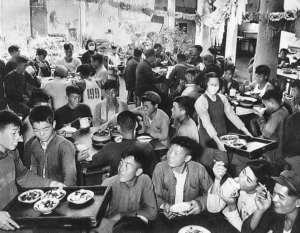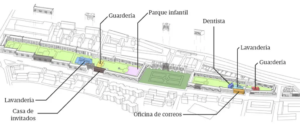The Cibcom Collective take aim at domestic realism, arguing that feminist planning of the domestic economy is necessary to the communist project. This is a translation of an article originally published in Jacobin América Latina.
Read by: Luke

For Black women today and for all their working-class sisters, the notion that the burden of housework and child care can be shifted from their shoulders to the society contains one of the radical secrets of women’s liberation. Child care should be socialized, meal preparation should be socialized, housework should be industrialized—and all these services should be readily accessible to working-class people.1
I
Most socialist, anarchist, and radical feminists of the 20th century believed that the definitive suppression of what we now call patriarchy was inseparable from overcoming the private or individualized domestic economy. Today, however, these debates have disappeared from the political map. Helen Ester, drawing on Dolores Hayden and making original use of Mark Fisher’s well-known concept, calls this situation domestic realism. The spatial design of the isolated household in which domestic chores are, in theory, the responsibility of either the adults in the nuclear family or their maids, has become so accepted and commonplace that no one seems able to imagine that we could live any other way.2
Of course, this lack of radicalism is not a problem exclusive to feminism. The socialist tendency is generally in low spirits. Until recently, no one on the left seemed to take seriously anything other than trying to save the remains of a zombie social democracy.3 It is only in recent years that we have witnessed a wave of research on the possibility of a socialist planning of the economy that overcomes the mistakes of the last century.4 Markets, money, and property, despite decades of media and academic propaganda bombardment, are once again being questioned.
The intention of this brief article is to try to convey the potentialities that these new debates have for the feminist cause, as well as to revive deeper research on this subject. Cybercommunism suggests that planned economies could give rise to alternative ways of organizing social reproduction, the domestic sphere, and care. After a brief review of the history of similar initiatives, we will try to explain how this can be done. But first, we provide a brief introduction on the continuing relevance of these questions.
II
Why would we want to change the way our homes work? Socialist feminism has long been demystifying our homes and explaining that, in addition to filial love, they contain explicit and implicit hierarchies and dynamics of domination.
Capitalism’s main sources of wealth are ecosystems and the sale and purchase of labor power. But the latter does not appear out of nowhere like mushrooms.5 It needs protection, food, attention, and education, i.e. care, in order to develop and recover. These tasks are partly performed today by schools and other institutions, but above all by the private family, which has historically been characterized by a sexual division of labor in which women (mothers, grandmothers, sisters, etc.) were in charge of care and men worked to bring home income.6 After the experience of World War II and the entry of women into the world of work, this structure was disrupted but retained its essential form: in addition to their new jobs, women have continued to carry domestic responsibilities, giving rise to the phenomenon of the double burden. They come home from work and begin to cook meals, do the laundry, take care of the rest of the family, clean, and so on. All these activities are undervalued and made invisible. They are rarely given credit, but everyone notices when they are absent.7
This situation is bearable for high and middle-income earners, since they can pay for private caregivers, nursing homes, day-care centers, etc., but is relatively untenable for working-class families, where mothers and grandmothers struggle to carry everything forward. The cultural campaigns of the left and other legislative initiatives that equalize maternity and paternity leave have helped to co-implicate men in these tasks, but do not guarantee an effective equitable distribution, and what is worse, they leave intact the problems that individual domestic economies generate at the social level.
What various theorists have rightly called the care crisis is a worldwide social problem that generates incalculable suffering among the population,8 and should be among the top issues for communists to address. The private household economy is an extremely inefficient institution in the use of time and resources, incapable of adapting to the demographic restructuring that is taking place. The plummeting birth rate, linked to the vital difficulties in achieving job stability, has led to a generalized aging of the population. Mothers and fathers combine double care hours and increasingly low-paid work schedules that result in chronic stress and intermittent neglect of those in need of care. Unable to afford private care services, children and the elderly suffer forced loneliness with serious psychological consequences. The case of the elderly is particularly worrying, as the deterioration of public pensions makes their situation even more dire.9
As we stated at the start of the article, this situation has been denounced by the most radicalized sectors of feminism for more than a century. Authors as disparate in time and space as Aleksandra Kolontái -although she did not consider herself a “feminist”-, Shulamith Firestone or Savvina Chowdhury have theorized on the need to organize the domestic sphere communally; to socialize care.10 While this would not wipe away the rest of the problems feminism addresses, it would make its cultural campaigns much easier and more effective.
III
Despite today’s limited historical memory, the fact is that there have been multiple attempts to socialize the domestic. As will be seen, they have all been linked to experiences of socialist planning in which the reconfiguration of urban planning and interior architecture has played a key role.
In the 19th century, different Owenist and Fourierist successors of what is now known as utopian socialism designed housing models in which they experimented with different ways of managing housework. Dolores Hayden’s The Grand Domestic Revolution, which recounts the specific U.S. experience with such initiatives, is one of the best works on this topic.11 In her book, Hayden recounts how the “materialist feminists” of this period are the first to propose that the spatial transformation of the home would give rise to a much more equitable and sophisticated type of housing, technologically and aesthetically, than the typical Victorian bourgeois dwelling. The well-equipped laundries and kitchens of hotels and other commercial spaces exemplified for them the possibility of optimizing their work, so they promoted the formation of communities of between fifty and five hundred people in apartment blocks, large hostels, and rural estates.

In these new cooperative enterprises, called phalansteries by the Fourierists, domestic chores were usually rotated, and the members who worked outside the community environment were entitled to part of their salaries. There were somewhere between 2000 and 3000 communes of this style in the USA.12 Many of them had a religious orientation and still do, while other communes can be attributed to either the hippie movement or were something like “nests” for workers’ cooperatives. In fact, the attempt to create micro-islands of emancipation survives today in the form of so-called “ecovillages,” in which participants attempt to use the so-called low tech for these purposes.13 However, the main problem with these approaches is that they lack a broad socio-political projection and err on the side of being the personal life plan of a few activists. Working women would have to wait for the less idealized but more effective experience of “actually existing socialism” to see large-scale initiatives where integral economic planning was directed towards alleviating the double burden.

In the early Soviet Union, and largely due to the influence of the Zhenotdel (Department of Women Workers and Peasant Women) led by Aleksandra Kolontai and Inessa Armand, women’s liberation would take center stage in Bolshevik politics. To this end, they envisioned a society in which soup kitchens, kindergartens, and public laundries would replace women’s unpaid work in the home. As Wendy Goldman details in Women, State and Revolution, the women of the Zhenotdel set out to reform society through laws that sometimes clashed with material reality, especially with the traditional structures of the Soviet peasantry as, for example, new divorce laws designed for city life did not adequately address the status of peasant property in common.14
One of the most striking ideas of the time, promoted by Kolontai, was the socialization of care for the young and, in particular, for orphans left behind by the war, known as besprizornost. Kolontai saw the socialization of care as part of her program to constitute a higher form of family, and these orphanages seemed indicated to be the first step. Despite the destruction of the war and the lack of resources, numerous care centers were built, where up to a quarter of a million orphans were sheltered (albeit in far from ideal conditions). With the advent of the New Economic Policy in 1922, many of these centers would be closed due to lack of funds and then their real impact would be seen: without these centers, many mothers could not care for their children and work at the same time. Married women stayed at home, reintroducing dependence on their husbands’ wages. And many single mothers or war widows would be forced to abandon their children to the streets because they could not combine domestic and work duties.
In 1930, the Zhenotdel would be abolished, as the feminist question was (erroneously) categorized as solved by considering that the elimination of private property, combined with the new institutions of the state, had solved the problems faced by women. Although women’s rights would suffer another setback with the entry into force of the family code in 1936, Soviet “welfare state” measures, later extended to other socialist bloc countries, would ease women’s lives and enable their incorporation into the workplace by alleviating the double burden. However, as Kristen Ghodsee writes in Second World, Second Sex, sexist ideas would not go away, or be culturally challenged. Women were still expected to do the housework in socialist countries, and the feminist question would be of little importance in almost all the bloc countries except Bulgaria, where there was a mass women’s organization that was relatively independent of the communist party and published a newspaper discussing women’s concerns.15
In parallel, the People’s Republic of China pursued its own path. During the first Maoist period, the collectivization of social reproduction was taken to extremes that were not replicated in other countries, especially in the agricultural communes. One of the objectives of commune construction was the liberation of women from domestic work, and to this end, many of the tasks performed by women, such as education, childcare, and food preparation and distribution, became communal. This last measure was made possible by the opening of around 2.6 million communal dining halls, where people could generally come and eat whatever they wanted. This utopian experiment did not survive long, and sadly the canteens are now known as a cause of the famine of 1958-9. This is mainly because food distribution was centralized in the hands of few people, and faulty implementation and management combined with poor harvests in an already poor and starving country exacerbated the bad situation that existed during the Great Leap Forward. Despite Mao’s insistence, the communal kitchens would be dismantled in the early 1960s.16

However, many institutions which alleviate the burden of social reproduction, mostly borne by women, from this period would survive to later days. During the Cultural Revolution, a second utopian period would give renewed impetus to collectivist measures, expanding public health care in a country where it was practically nonexistent, although the major focus of this period was to break down the cultural barriers that tied women to domestic work and prevented them from performing many jobs. To this end, measures were taken such as enacting maternity and opening many schools.17 With the reforms of Deng Xiaoping many of these gains would be reversed at the end of the seventies.18

IV
Even though the aforementioned experiences represented notable advances in the situation of women, they presented serious limitations and drawbacks. The utopians’ islands of socialism experimented with forms of integral economic planning from which much can be learned, but they fell into the oblivion of their own isolation. The USSR’s efforts to develop public services for women were commendable, and while they made life much easier for women than for their Western counterparts, they did not ensure an effective sharing of domestic tasks. The agricultural communes of Maoist China tried to attack the root of these problems in a much more radical way, but in their attempt they overreached and generated forms of life that were perhaps too intrusive and not compatible with the demands of privacy which we today understand as basic.
Nevertheless, intermediate paths aim to bring the best of both worlds. In 1993, Paul Cockshott and Allin Cottrell published Towards a New Socialism, a systematic work in which they set out the technical and institutional foundations of a socialist planning of the economy updated by the new digital technologies.19 In chapter 12, entitled “The Commune,” they argue that cyber-socialism and feminism could converge in the revolutionary struggle because of the possibilities that the planned economy offers for the massive proliferation of urban communes. What are these urban communes and why should they be of interest to the feminist cause?
Urban communes are architectural structures that combine the socialization of household chores through dining rooms, laundries, nurseries, and communal cleaning services, etc. with apartments and individual rooms in which families and their members have all the privacy they need. There are several potentialities within them.
In the first place, by assigning tasks to a small group of people, professionalizing them or rotating them among the members of the community, we ensure a mortal blow to the sexual division of labor, which discriminates against women. In other words, by guaranteeing that most of the tasks such as cleaning and cooking are carried out by communal agents who meet the community’s criteria, we ensure that this work does not end up falling to our mothers and grandmothers.
Second, we enjoy the benefits of economies of scale. It is much more efficient in terms of time and resources for one person to cook for a hundred people than for each of those hundred to cook for themselves. Also, large scales allow for the application of scientific and technological criteria more easily. By socializing the menu, for example, we can ensure that the members of the commune have access to a balanced diet, as well as invest in better facilities that they could not afford individually. It may seem that this would reduce everyone’s freedom of choice, but the key to this is that each urban commune would decide for itself how to implement public recommendations for sanitation and usability. Going back to the cooking example, there are hundreds of thousands of possible recipes that could be valid and there is no reason not to offer several options on the same day.
Children and the elderly would benefit from the communal space even with the falling birth rate, since, by optimizing the management of tasks, more time would be available to care for them, and what is more important: by generating communal spaces for leisure and supervision, we ensure a full social net, from the cradle to the grave, of the entire neighborhood, thus developing much closer relationships.
It is possible that, even after having explained the above, one thinks that urban communes will be apartments in which three or four families live in overcrowded conditions. To get an idea of what this would imply, it might be interesting to recall the experience of Red Vienna between 1919 and 1934, despite all its limitations.

In Principles of Communism, Friedrich Engels argued that the proletarian revolution should have among its priorities the “construction, on public lands, of great palaces as communal dwellings for associated groups of citizens engaged in both industry and agriculture and combining in their way of life the advantages of urban and rural conditions while avoiding the one-sidedness and drawbacks of each.”20 The government of the Social Democratic Workers’ Party did not succeed in abolishing the distinction between town and country, but it built the closest thing to workers’ palaces that ever existed; palaces for women workers would be more correct. Huge buildings such as the Karl-Marx-Hof house some 1300 individual dwellings which have access to communal services ranging from laundries and toilets to pharmacies.21 In all of these, “the utmost attention is paid to common services, to the liberation of women from domestic slavery.”22

An indication of the potential that these institutions have for the care crisis is that they are still on the horizon of initiatives such as feminist urbanism,23 which aims to generate these community spaces even within the bourgeois state. But in the context of market economies, where only monetarily profitable initiatives are rewarded, it finds only limitations. It seems no coincidence that the only places where similar projects are being carried out are Venezuela and, particularly, today’s China, where the public sector continues to have considerable weight in the economy.24 The new capsule neighborhoods in regions such as Xiong’an bear striking similarities to the above.25 On the other hand, the recent “Integrated Community Development Plan” aims to encourage regional administrations to promote the consolidation of integrated communities based on the existing urban fabric. The idea is to develop strategically located communal services within a ten-minute walking distance that are affordable and allow for communal living.26

Nevertheless, an essential caveat of feminist urbanism must be emphasized: as authors such as Liisa Horelli explain, the socialization of reproductive work does not automatically dissolve the sexual division of labor. Therefore, cultural campaigns are necessary to prevent communal care services from being performed mainly by women, as well as to make them visible and dignified.27
V
In short, we are talking about an extremely sensitive subject that requires reflection on very intimate aspects of the social psychology of our world. When these alternatives and their history are discussed today, it is common to observe a certain suspicion that leads to rejecting them outright as soon as one becomes aware of any of their problems. However, it is necessary to emphasize something that is indisputable: even though these proposals were far from perfect, the situation of women worsened -very much- when they were absent. Therefore, it seems reasonable to reflect on how we could learn from their successes, while trying not to repeat their mistakes.
Urban communes should not be taken as the definitive solution to the problems mentioned, but as an attempt to reopen the debate on these issues and combat domestic realism. If socialism intends to return to being a mass movement it must find ways to radicalize the current social movements among which feminism cannot be ignored. To do this effectively, the discourse cannot be framed as a mere attack on the limits of a hegemonic feminism, but as the need to remember what revolution, economic planning and true democracy have to offer to half the world’s population.
We need a socialist and feminist urbanism. Socialist, insofar as it is capable of mobilizing time and resources in a planned manner for multidimensional objectives that go beyond profitability, but also productivity,28 and feminist, insofar as it is conscious of and committed to effectively overcoming the sexual division of labor in the communal spaces generated.

- Angela Davis. Women, Race and Class. 1981. Chapter XIII.
- Helen Hester. Promethean Labors and Domestic Realism. 2017. Available at: https://www.e-flux.com/architecture/artificial-labor/140680/promethean-labors-and-domestic-realism/.
- Andrew Kliman. Post-Work: Zombie Social Democracy with a Human Face? 2017. Available at: https://www.marxisthumanistinitiative.org/alternatives-to-capital/post-work-zombie-social-democracy-with-a-human-face.html.
- Fréderic Legault and Simon Tremblay-Pepin. A brief outline of three models of democratic planning. 2021. Available at: https://cibcom.org/un-breve-esquema-de-tres-modelos-de-planificacion-democratica/.
- Amaia Pérez Orozco coined the concept of “mushroom worker” to explain how capitalist culture makes reproductive work invisible. According to her coordinates, “the only relevant population is the business sector and that part of the families that go to the labor market. The rest is a burden, socially desirable, but economically costly. The way of understanding working people is that which, from the analysis focused on care, we have called the mushroom worker: the one who only matters insofar as he/she is incorporated into the productive process. It does not matter where he/she was before coming to the company or where he/she goes when he/she leaves. It is assumed that with his salary he solves everything, since he has no desires beyond those he covers with mercantile consumption. Nor does he have responsibilities for the welfare of others that are recognized as something that interferes with or conditions his labor insertion. However, this mushroom worker is not such: someone has taken care of him when he was a child, he does it when he gets sick, he will do it when he gets old; somehow he manages his daily regeneration, both physical and emotional” (Amaia Pérez Orozco. Feminist subversion of the economy. On the capital-life conflict. 2019).
- Friedrich Engels. The origin of the family, private property and the state. 1884.
- Lourdes Benería. Reproduction, production and sexual division of labor. 1981.
- Tithi Bhattacharya. Social Reproduction Theory. Remapping Class, Recentering Oppression. 2017.
- Helen Hester and Emma Dowling. The future of care. 2021. Available at: https://autonomy.work/portfolio/ffp-hester-dowlingconvo/.
- Alexandra Kollontai. Women in social development. 1921; Shulamith Firestone. The dialectic of sex. 1970; Savvina Chowdhury, Peter Bohmer and Robin Hahnel. Reproductive work in a socialist participatory society. 2021. Available at: https://cibcom.org/el-trabajo-reproductivo-en-una-sociedad-participativa-socialista/.
- Dolores Hayden. The Grand Domestic Revolution: A History of Feminist Designs for American Homes, Neighborhoods and Cities. 1982.
- Yvonne Daley, What happened to America’s communes? 2021. Available at: https://www.notiulti.com/que-paso-con-las-comunas-de-estados-unidos/.
- Juan Victor Macanás Muñoz. Ecovillages: reflections, feminism and audiovisual walk. 2017.
- Wendy Z. Goldman. Women, the State and Revolution Soviet Family Policy and Social Life, 1917-1936. 1993.
- Kristen Ghodsee. Second World, Second Sex Socialist Women’s Activism and Global Solidarity during the Cold War. 2019.
- Gene Hsin Chang and Guanzhong James Wen. Communal Dining and the Chinese Famine of 1958-1961. 1997.
- Dan Connell and Dan Gover. China: Science Walks on Two Legs. 1974; Ruth Sidel Victor W. Sidel, Women and Child Care in China: A Firsthand Report. 1973.
- Dongping Han. The Unknown Cultural Revolution: Life and Change in a Chinese Village. 2008.
- Paul Cockshott and Allin Cottrell. Towards a New Socialism. 1993. Available at: https://cibcom.org/hacia-un-nuevo-socialismo-1993/.
- Friederich Engels. Principles of Communism. 1847. Available at: https://www.marxists.org/espanol/m-e/1840s/47-princi.htm.
- Irene Armelles Bello. Evolution of the social housing production model in Vienna. Analysis from the dual socio-economic and urban form perspectives. 2020. Available at: https://oa.upm.es/63379/1/TFG_Jun20_Armelles_Bello_Irene.pdf.
- Manfredo Tafuri. Das rote Wien. Politics and residential architecture in socialist Vienna. 1989.
- Dolores Hayden. What Would a Non-Sexist City Look Like? Speculations on Housing, Urban Design, and Human Work. 1980; Col-lectiu Punt 6. Urbanismo feminista: por una transformación radical de los espacios de vida. 2019.
- Cira Pascual Marquina and Chris Gilbert. Venezuela, the Present as Struggle: Voices from the Bolivarian Revolution. 2020.
- Will our future be living in Xiong’an-style capsule neighborhoods? 2020. Available at: https://www.construdata21.com/2020/11/19/sera-nuestro-futuro-vivir-en-barrios-capsula-al-estilo-xiongan/.
- The Chinese State Council issued the 14th Five-Year Plan on “Planning the Construction of Urban and Rural Community Service System“ last year: https://www-gov-cn.translate.goog/zhengce/content/2022-01/21/content_5669663.htm?_x_tr_sch=http&_x_tr_sl=zh-CN&_x_tr_tl=es&_x_tr_hl=es&_x_tr_pto=sc. A user recently posted a thread explaining its concretions: https://nitter.net/zhao_dashuai/status/1588802108736036864?t=IWKdnvqftfVucb5qZKtR9A&s=19.
- Col-lectiu Punt 6. Feminist urbanism: for a radical transformation of living spaces. 2019.
- Aaron Benavav. How to make a pencil. 2020. Logic Magazine.




